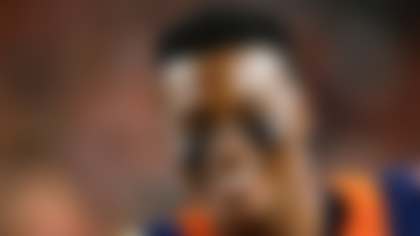In the NFL, it is frequently noted that you must have a franchise quarterback to make a serious run at the title.
While there have been a few notable exceptions, a look at the list of Super Bowl winners features some of the game's best quarterbacks.
The Baltimore Ravens thought that they had their franchise quarterback when they selected Joe Flacco with the 18th pick of the 2008 NFL Draft.
At 6-foot-6, 238 pounds, he possessed all of the physical attributes required of the position, and instantly delivered on his immense potential by leading the team to the postseason in each of his three seasons at the helm. His 36 wins over the first three seasons of his career, including the playoffs, tied an NFL record established by Dan Marino, and his back-to-back 3,600-yard seasons have prompted many to suggest that he is on the verge of becoming the league's next great quarterback.
But after watching Flacco melt down in the playoffs for the third consecutive year, the jury is still out on whether he has what it takes to lead the Ravens to a Super Bowl title.
Granted, his combination of wins and regular-season statistics make it hard to question his standing on the team, but his postseason failure should be a growing concern. While he has guided the team to four playoff wins, he has completed just 53.2 percent of his passes with four touchdowns and seven interceptions in seven postseason games. Those numbers represent a significant drop off from his regular-season production, where he has connected on 62 percent of his passes and enjoys nearly a two-to-one touchdown-to-interception ratio (60 touchdowns against only 34 interceptions) in his career.
Given the impact that a quarterback's performance has in the postseason, it is concerning that he has not been able to take his game to a new level when the pressure is on. This year, in particular, has to be troubling because he was playing with an upgraded offensive cast that was expected to lead to a deep playoff run.
The argument could be made that Flacco's supporting cast (Anquan Boldin, Ray Rice, T.J. Houshmandzadeh and others) came up short when it mattered most. However, a close examination also reveals a flustered quarterback not quite ready to put the offense completely on his shoulders. He clearly possesses the arm strength to make big-time throws, but has failed to make the critical completion that changes the momentum of a game. Until he provides that moment while leading the Ravens to a big victory in the postseason, he will be viewed as a game manager rather than a playmaker.
In a league driven by quarterbacks, the Ravens need Flacco to be more than a caretaker to emerge as a Super Bowl champion. With another early exit from the playoffs, they can only hope that he takes another step in his development this offseason.
The Ravens' issues go beyond Flacco. Here's a look at some other key questions:
1. Will Ravens lock up Ngata?
Haloti Ngata has become the most dominant interior player in the game, and the Ravens rely on his unbelievable combination of skills to disrupt offensive game plans. At 6-foot-4, 350 pounds, he overpowers blockers with his brute strength, but also possesses uncanny athleticism for his size. His lateral quickness and movement make him a versatile playmaker in the Ravens' exotic scheme. In fact, he might be irreplaceable. With Ngata ranking as one of the few impact options at the position, the Ravens cannot afford to let him walk.
2. What is the offensive identity?
Coordinator Cam Cameron has attempted to open up the offense, but the results have been mediocre at best. The unit finished 22nd in total offense, and their 22.3 points per game ranked 16th in the league. While he has repeatedly attempted to air it out with Flacco, the unit clearly functions better when it runs through Ray Rice. The Ravens were 9-1 when he had 19-plus carries, and the emphasis on the running game allowed the offense to bully opponents at the point of attack. With the Ravens' title window closing fast, the pressure is on Cameron to quickly identify the right approach.
3. Can Baltimore add an explosive receiver?
Boldin upgraded the aerial attack because he provided Flacco with a legitimate No. 1 option. Although he is capable of thriving as a possession receiver, he is not a vertical threat. The missing element allowed defenders to clamp down on the passing game in critical situations. With the other receivers lacking elite speed, general manager Ozzie Newsome must find a blazer in the draft or free agency to help a talented offense fulfill its potential.
4. Will Newsome upgrade the secondary?
If Newsome needed a reminder of the Ravens' Achilles' heel, he only needs to look at a replay of the infamous third-and-19 bomb by the Steelers to see the lack of speed and athleticism at corner. The 58-yard completion to Antonio Brown continued a season-long trend of surrendering big plays in the passing game. The issue must be addressed to keep the defense among the ranks of the elite. Given the free-agent status of Fabian Washington, Chris Carr and Josh Wilson, expect to see a new crew of cornerbacks next season.
5. How will Ravens reshuffle line to maximize talent?
The Ravens moved Michael Oher to left tackle after his stellar rookie season on the right side. While he was solid, he lacks the quickness and feet to handle premier rushers on Flacco's blindside. The move also forced Marshal Yanda to slide over from his more natural position of guard to play right tackle and left the Ravens without a power side in the running game. If they can reshuffle things to get Oher and Yanda back to their familiar positions, they can return to being one of the best rushing attacks in the league.




